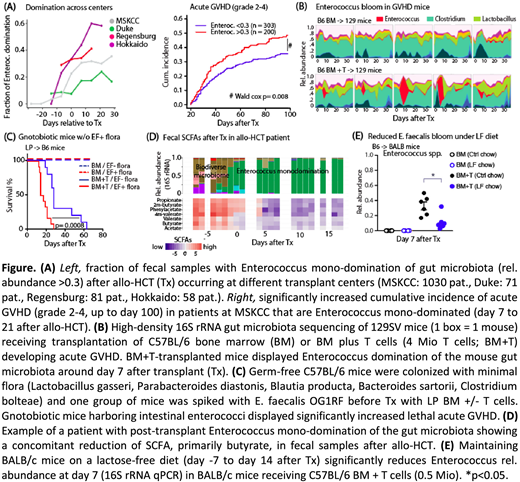Abstract
Introduction:
Increasing evidence suggests that the intestinal microbiota is involved in the development of acute graft-vs.-host disease (GVHD) after allogeneic hematopoietic cell transplantation (allo-HCT). We previously reported in single center studies that Enterococcus a) is associated with GVHD (Holler et al., BBMT 2014) and b) can dominate the post-transplant gut microbiota in up to 50% of allo-HCT patients resulting in a 9-fold increased risk of bacteremia (Taur et al, CID 2012). To further investigate the hypothesis that Enterococcus can trigger the development of GVHD, we studied both allo-HCT patients and pre-clinical mouse transplant models.
Methods and Results:
Stool samples from 1240 allo-HCT patients at 4 different transplant centers in the U.S., Germany and Japan were collected approximately weekly during inpatient hospitalization. The V4-V5 region of the bacterial 16S rRNA genes from 6718 samples was sequenced at one central site on the Illumina platform. We observed Enterococcus mono-domination (relative abundance > 30%) in post-transplant samples ranging from 20 to 60% of patients at different centers (Fig. A, left). This mono-domination was primarily attributable to E. faecium, and was associated with a significantly increased risk for grade 2-4 acute GVHD (Fig. A, right). In three different mouse models we found a transient bloom of E. faecalis around 7 days after transplant in allo-HCT recipients with GVHD (Fig. B; C57BL/6 -> 129SV model). This bloom did not occur in allo-HCT recipients of a T cell depleted allograft without GVHD. To further investigate this Enterococcus bloom, we treated mice with an experimental E. faecalis-strain on days 4 to 6 after transplant and found significantly increased lethal GVHD. Colonizing germ-free mice with a minimal gut flora also lead to increased lethal GVHD when enterococci were added to the gnotobiotic flora (Fig. C). The allo-HCT recipients with Enterococcus-containing flora had also increased serum IFNg levels. Short chain fatty acids (SCFA) can be protective against GVHD and gut inflammation through maintenance of epithelial homeostasis and increases in anti-inflammatory regulatory T cells in the gut. In BMT mouse models, we found that Enterococcus-dominated allo-HCT recipients with GVHD have significantly less cecal butyrate, a major SCFA. Similarly, Enterococcus domination after allo-HCT also leads to a decrease in fecal SCFAs in patients (Fig. D). Next, we hypothesized that intestinal IgA might have a protective role against this pathogen in mice. 16S sequencing of flow sorted IgA-coated vs. non-coated bacteria from fecal samples of allo-HCT patients and transplanted mice revealed no specific IgA-coating pattern of enterococci both before or after transplant rather excluding the hypothesis that IgA might have a protective role against Enterococci. E. faecalis and E. faecium use the disaccharide lactose as a major carbohydrate source for growth and expansion as observed by analyses of the Enterococcus genome and in vitro growth experiments. In mice, we observed that a lactose-free diet significantly decreases the Enterococcus bloom after transplant in allo-T cell recipients and in first survival experiments attenuates lethal GVHD (Fig. E).
Conclusion:
Our studies in mouse and man demonstrate that the abundance of Enterococcus in the intestinal flora plays a role in the development of GVHD and the prevention of Enterococcus growth with a lactose-free diet can ameliorate GVHD.
Peled:Seres Therapeutics: Research Funding.
Author notes
Asterisk with author names denotes non-ASH members.


This feature is available to Subscribers Only
Sign In or Create an Account Close Modal